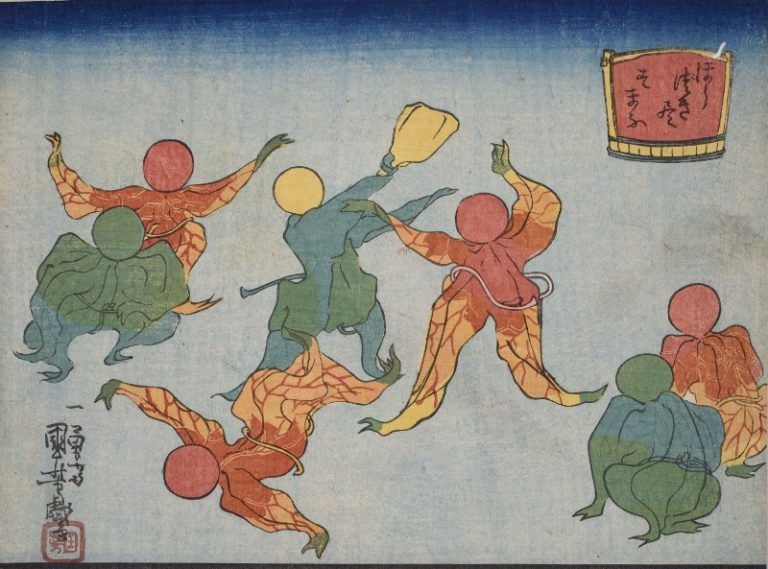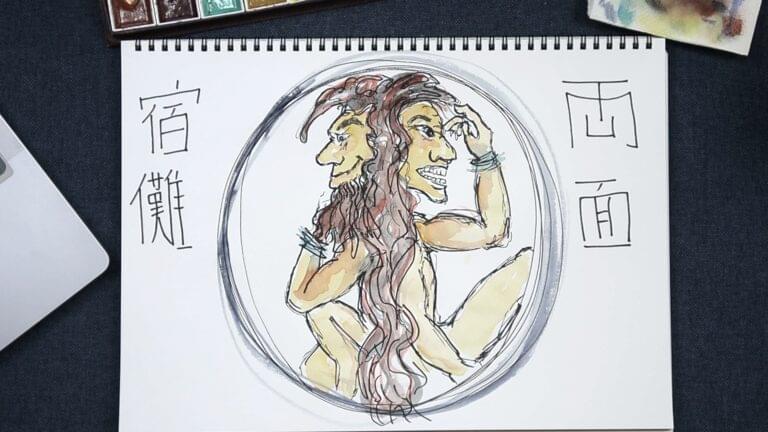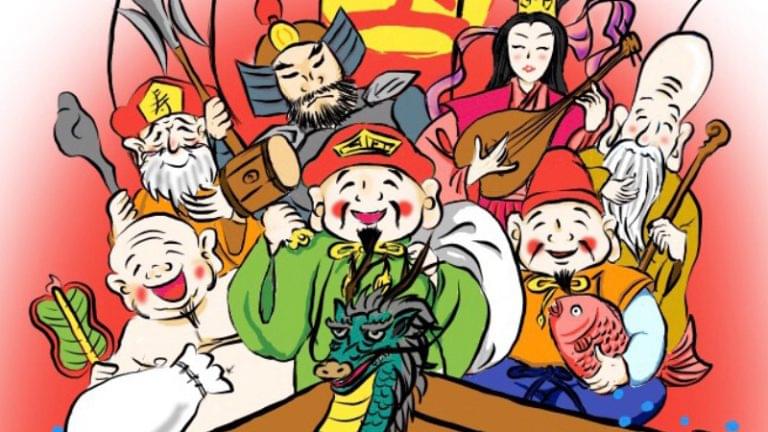On today’s episode I’m going to tell you about an affliction that involved a strange growth on some part of your body that had the face of a human and did horrible things.
Hey hey, this is Thersa Matsuura and you’re listening to Uncanny Japan.
I want to preface today’s show by saying my heart is with Ukraine right now. I can’t say much or I’ll start upset again. But we do have a small handful of listeners from Ukraine. Please stay safe.
When’s the last time I grossed you out? Oh, yeah, let’s go there. I promise it won’t be overly disgusting. I have somewhat of a weak stomach myself and I don’t think you want to hear me retching on the show, so I’ll keep it tame, low key gross. But also, pretty fascinating gross, too.
Today let me tell you about a the Human-Faced Tumor, a yokai called the Jinmensou/人面瘡.
Hey there! For everyone who didn’t bail after hearing that title, I commend you and I thank you for being brave. I’d also like to thank Dollar Rain, my very patient, very has-a-lot-of-great-ideas patron who has been with me since 2017. Yes, that is me you hear wiping away tears and tackle hugging my computer because I have no in real life Dollar Rain to tackle hug and cry on.
So Dollar has given me quite a few brilliant suggestions for topics that I’ll be getting to throughout the year. And that leads me naturally to thanking all the patrons and supporters of the show. I say it and wish I could say it more often and better, but I really appreciate your support. Because of you, I can do this podcast. I still can’t put full time hours in, because of side gigs to pay other bills, food, life stuff. But my dream is to make a living writing and podcasting and telling stories. You all get me closer to that day.
Oh, one thing I’m working for my kitsune ($5) and up patrons is I’m combining January, February and March Bedtime Stories into a super duper story. I’m translating and retelling the tale of Shuten Douji.
Shuten Douji Folktale
The Shuten Douji/酒呑童子 (a kind of drunken oni king) story has been told through the ages and has several different versions, but I have yet to run across an English one — other than a quick rundown of the plot, that is. So I want to do the tale justice. Make it absolutely beautiful, wickedly horrible, and wonderfully multi-layered. I’m really excited with how it’s coming along.I think I’m also going to publish it as an audio short story for those interested in that.
Now let’s get into talking tumors. Gag.
What do the Characters Mean?
As I usually do, let’s start with the characters. Jinmensou/人面魚. Quiz! Do you remember what Jinmengyou means? Episode 30? Did someone say Human-Faced Fish? Exactly! Jin men/人面 human face, gyo meaning fish, just like kingyo (again) literally goldfish.
So I noticed that jinmensou/人面瘡 is often translated into the Human-Faced Tumor in English. But I have my opinion on the matter. I’m familiar with the kanji for sou because I used to have a mild obsession with small pox awhile back, especially, housougami/疱瘡神 The God of Smallpox, Episode 18.
In that case sou means a pustule or pox. (Eyu, I know.) It can also mean boil or any kind of sore that erupts on the skin. If you do an image search for the kanji character sou — which I don’t recommend — most of the photos are of people with bad cases of acne. Acne isn’t a tumor.
Sou is also the first character in the word scab: kasabuta/瘡蓋 which delightfully translates as sore lid or boil lid. “Sou” you can see that it’s not quite ‘tumor’. When I think tumor I think things like inoperable and malignant. In this case, perhaps a growth is the best translation.
What is a Jinmensou?
Now let’s begin. A jinmensou is a growth that appears on some part of your body. But somewhere along the way you notice it has a human face. And not just that, sometimes it eats and talks.
Old Tale about Jinmensou
Long, long ago, in the 1600s, an author and monk named Asai Ryoui wrote about this phenomenon in Volume 9: Jinmensou of his bizarre collection of stories entitled Otogibouko. Which, I’m putting this out there, were quite influenced by Chinese culture.
His story went something like this: Mukashi, mukashi, once upon a time, in what is now Uji City in Kyoto, there lived a farmer who fell very ill and wasn’t able to recover. Six months after he got sick, he noticed he had a strange growth on his knee. It was incredibly painful. He examined it closer.
Odd. It resembled a human face with eyes and a mouth, a jinmensou. But that had to be a coincidence, right? Then one day while drinking to try and numb the pain, this farmer poured a little of the sake into the ‘mouth’ of his knee jinmensou. To his surprise, the tiny mouth drank it up! And not only that, but after several pourings, the jinmensou flushed red as one does when they get drunk.
Ookay, the farmer thought, how about some of this mochi rice cake I’ve got on my table? He pulled off a little piece of the sticky treat and fed this to his animated knee-thing and what do you know, it began chewing and even swallowed it.
Now you have to know that all this was terribly painful for the poor farmer, but what he quickly learned was that is that if he DIDN’T feed the freaky yokai on his leg, it would become even more painful. So he continued nourishing the parasitic jinmensou every single day, sacrificing his own meals to the dreadful knee beast. Before long the farmer was only skin and bones.
And it wasn’t like he didn’t try to get help either. He did visit doctors and healers, but no one had any treatment for his affliction, mostly they were freaked out. Death by starvation was near for the poor farmer, but still the jinmensou cried out for more to eat and drink.
Then one day when all was at its worst, a wandering ascetic monk happened to show up in town. He listened to the farmer’s dilemma.
“I can help,” he said. “But I need you to do something.”
He got the farmer to sell off all his land for gold which he used most of to buy various medicines and herbs. The ascetic then took these and fed them one by one into the jinmensou’s greedy mouth. Every single time it would gobble them up, and cry out for more. This went on for sometime until at last he tried to place some powdered baimo/貝母, or Snake’s Head Lily into the creature’s maw.
That time, though, the jinmensou closed tight its mouth and refused to eat.
Aha! The monk said and force fed the mouth the powdered flower. The farmer felt better. After seventeen days, the swelling went down, the mysterious growth disappeared and farmer completely recovered.
The end.
Origin of Jinmensou
But that’s not the first mention of a jinmensou. There are ancient Chinese medical texts that also mention the condition.
There are it seems existing medical documents in Japan as well.
For example, there’s one dated July of 1819 about a 35-year old Sendai merchant who came in to be examined. He had a suspicious looking growth on his knee that had been there since he was 14-years old. Every year it grew and grew, and it wasn’t until that day in July when he decided to do anything about it. I wonder what happened to spur that.
The doctor described the affliction in grotesque detail, but the basics were it had swollen parts that made it look like it had a pale red mouth, two nostrils, eyes that were closed but looked to be those of a smiling face. It even had ears. The doctor said if he touched it, it would bleed, but that there was no pain in the patient. Which is different than our farmer who suffered greatly by the jinmensou’s hand, I mean head, I mean face.
But not just that. The little beast also twitched which made it look like it was breathing. Although the doctor noted that could have been the man’s heartbeat making it look like it was breathing. Either way. Creepy.
This doctor’s diagnosis, judging (I suppose) from the fact that it looked SO much like a human face, was that it must be an akyuryou or onryou, an evil spirit of someone dead or someone who has so much malice directed toward the victim it manifests itself in some way, say, face on a random body part, anyone?
Which I can’t help wonder. If you had a jinmensou that was the face of someone cursing you, you’d like know immediately who it was, no? Hey! That’s Hirotaka. That jerk. Then you just confront them, show them the jinmensou with their face and go, cut it out already. Maybe it didn’t work that way.
So these creatures are considered youkai and they can appear anywhere on your body but I read the knee seems to be preferred.
Are They Still Around?
While they’re an old timey condition, they are still found even now in the manga and anime world, a novel by the same name, and even in a song by the heavy metal band Ningen Isu. So you can check that out if you like.
So, you know, just keep an eye on any suspicious freckle or mole. For various reasons, but one of which you might be growing yourself a jimensou. Oh, did I mention they sometimes talk, too? How’s that for disturbing?
I want to thank everyone who listened to the new Uncanny Robot Podcast. We’ve got a space adventure story coming up. Parallel earth’s, strange alien creatures, Mushi-blooms, Blast Cannons, green goo, and possible annihilation.
Also, remember to keep sending me any uncanny, ghostly, freaky or even funny stories that happened to you while living in or visiting Japan. Richard and I will read and talk about them on the 100th episode. I’m getting a bunch of good ones.
Thank you! Bye bye!
Credits
Intro and outro music by Julyan Ray Matsuura






